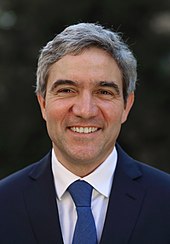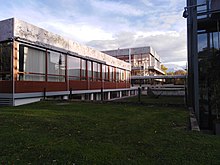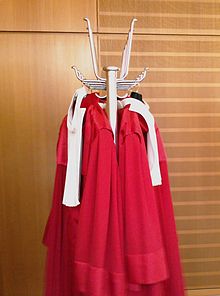Federal Constitutional Court
In the Federal Republic of Germany, the Federal Constitutional Court (Bundesverfassungsgericht, BVerfG), as the constitutional court of the Federation, is both the highest independent constitutional body of the judiciary, ranking equally with the other supreme federal bodies, and the highest court at federal level. It thus exercises a dual function. In this context, the Federal Constitutional Court is responsible for controlling the constitutionally determined political life, which it interprets in the light of the Basic Law, with particular regard to the individual fundamental rights of the citizen. In this respect, the Court, in its capacity as guardian of the German Constitution, has been granted the fundamental power of order over the Constitution in the context of social change.
On the other hand, the General Court is the highest body of jurisdiction. In this function, it occupies a special position vis-à-vis all other courts, for it is empowered to set aside their judicial decisions. The decisions made by the Federal Constitutional Court are legally binding and have the force of law with respect to federal and state legislation. Although the Federal Constitutional Court controls the decisions of other courts, it is not part of the court system. It does not exercise technical control, but reviews whether the decisions made by the specialised courts are in conformity with the Basic Law. If it comes to the conclusion that there is a violation of the Constitution, it overturns these decisions - as well as, if applicable, decisions of the lower courts - and refers the matter back to the non-constitutional courts for reconsideration (§ 95.2 of the BVerfGG).
The highest German court is the Federal Constitutional Court, because it can annul acts of all administrative levels or order them to act in the case of omissions. The decisions of the court are not contestable by state organs or by others. Pursuant to § 31 of the BVerfGG, the formulas of certain decisions of the Federal Constitutional Court are promulgated in the Federal Law Gazette.
The court has its seat in Karlsruhe. As a constitutional body, it is surrounded by a pacified district. It is protected by the Federal Police.

Stamp of the German Federal Post Office (1976)

50 years of the Federal Constitutional Court . The last coin of the Mark currency (2001), designed by the artist Aase Thorsen.

Hearing of the Second Senate, 1989

Courtroom building of the Federal Constitutional Court

Portrait of the acting president Stephan Harbarth

The judges' building of the Federal Constitutional Court in the Karlsruhe castle district (occupied 1969)
History
Previous story
Constitutional jurisdiction in Germany is not a post-World War II institution. Institutions such as the Reichskammergericht (Imperial Chamber Court) from 1495 and the Reichshofrat (Imperial Court of Appeal) from 1518 were already dispensing justice between organs of state.
Modern constitutional jurisdiction has its origins in a decision of the US Supreme Court of 24 February 1803, which was based on the famous Marbury v. Madison case. This was the first time that a law had been declared unconstitutional. It should have been possible to proceed according to this model under § 126 of the Paulskirche Constitution of 1849, according to which the Imperial Court would have been endowed with far-reaching state and constitutional court powers if the norm had been given effect. In 1850, the Bavarian State Court of Justice, the first special court for constitutional questions, came into being in Germany. The Constitution of the German Empire of 1871, on the other hand, did not provide for a constitutional court. In 1919, the Weimar Constitution introduced a constitutional court with limited competences in the form of the State Court for the German Reich, as its jurisdiction was limited to proceedings between the Reich and the Länder.
From 1924 onwards, there was an extended and controversial discussion among academics, after judges of the Reich Court had considered reviewing laws in the future for their constitutional compatibility, if necessary. The majority voted against it, and Carl Schmitt in particular distinguished himself in 1929 with his essay Der Hüter der Verfassung (The Guardian of the Constitution). In it, he argued that judges had no competence to do so, since they were responsible for applying the law, but not for reviewing it; this competence fell instead to the Reich President. With Hitler's appointment as Reich Chancellor, however, a process of constitutional destruction was subsequently initiated, which in the years 1948/49 and thus after the war, within the framework of the Constitutional Convention of the Parliamentary Council in Herrenchiemsee, led to the realization that in the future a constitutional court capable of being enforced would be needed.
The constitutional body
With the Federal Constitutional Court (Bundesverfassungsgericht, BVerfG), the Basic Law for the Federal Republic of Germany (Grundgesetz für die Bundesrepublik Deutschland, GG) provided for a sui generis legal infrastructure from 1949 onwards. Two years after the entry into force of the Basic Law, the Court began its work in 1951, at that time consisting of two senates, each with twelve judges, half of whom were elected by the Bundestag and half by the Bundesrat. Within the following twelve years, the number of judges in the two panels was successively reduced, in 1956 to ten, in 1963 to eight. The background to this was a tough struggle between the parties for the political majority, in which Adenauer's CDU ultimately gained the upper hand.
The first decisions were taken on 9 September 1951. However, the Court was not officially opened until 28 September 1951 by the then Chancellor Konrad Adenauer; this date went down in the annals of the Court as "Opening Day". As early as 1952, the Court experienced its first crisis in the constitutional dispute over rearmament, when it faced fierce protests, in particular from the then Minister of Justice Thomas Dehler, postponed the decision until the 1953 Bundestag elections and ultimately, after Adenauer's clear electoral victory and due to his amendment of the Constitution, no longer needed to rule in accordance with Article 73(1) of the Basic Law.
From 1951 to the end of 1990, 76,623 constitutional complaints were decided in 80,046 proceedings, of which 2.25 percent were successful. By 2005, the number of constitutional complaints nearly doubled to 151,424. By the end of 2017, the number of constitutional complaints had further increased to 224,221; of these, only 5,088 were successful, representing only 2.3 percent of the proceedings.
The establishment, tasks and composition of the Constitutional Court are regulated in Articles 92 to 94 of the Basic Law. Further rules on organisation, powers and procedural law are found in the Act on the Federal Constitutional Court (BVerfGG). Unlike the other constitutional organs of the Federation, the Court needed to be constituted by this Act. Karlsruhe, the former seat of the Baden dynasty, was chosen as its seat, as it was seeking to compensate for the loss of its function as a capital city after the Second World War and had therefore already become the seat of the Federal Court of Justice since 1950.
Service building
From 1951 to 1969, the Federal Constitutional Court had its first official seat in the Prinz-Max-Palais, a historicist city villa in the west of Karlsruhe's city centre. When in 1960 a move to Munich was threatened due to the growing need for space and the Court's desire for representation, the City of Karlsruhe and the State of Baden-Württemberg made the site of the Court Theatre, which had burnt out during the war, available for a new building. It is located in the western part of the palace district between the palace, the State Art Gallery, the palace square and the botanical gardens, in the immediate vicinity of the centre of the baroque city layout, which runs in a fan shape towards the palace. The architect Paul Baumgarten had previously won the competition for a new theatre building with a modern design and was now commissioned to build the courthouse on the same site.
According to Baumgarten's plans, a complex of five pavilion-like, staggered structures with flat roofs and a square ground plan was built from 1965 to 1969. They are arranged over a total length of 170 metres along a glazed connecting passageway and embedded without fencing in the parks that were redesigned at the time for the Federal Garden Show in 1967. The conference hall building is the highest and faces the Schlossplatz the closest. To the north are the judges' building, built in a ring around an open inner courtyard, and an administrative building. The library is located behind the conference hall building, and the casino faces the Kunsthalle. The steel skeleton buildings have generous glass fronts framed in Oregon wood elements, the closed surfaces are clad in grey cast aluminium panels. The architecture is intended to represent the basic democratic order with sober forms and transparency, thus clearly setting itself apart from the monumental palaces of justice of the 19th and early 20th centuries. The architectural model was the German Pavilion at the 1958 World Exhibition by Sep Ruf and Egon Eiermann. The end wall in the large conference room is dominated by an asymmetrically mounted eagle relief created in 1969 by Hans Kindermann, then rector of the Karlsruhe Art Academy.
The increased workload, also as a result of German reunification, and the great distance to the new federal capital Berlin led to new considerations regarding an expansion or relocation of the court. The political demand for a relocation to Leipzig in the new Länder did not prevail. Expansion and conversion plans were controversial, as both the courthouse and the adjacent botanical garden are listed monuments. Due to the lack of space, the western extension of the palace was used as a registry and connected to the court via an underground passageway in 1992. In 1995, the casino, which had been open to the public until that time, was converted into staff quarters and the library was given additional underground deep storage. In 2000, a majority of the constitutional judges voted to remain at the Karlsruhe site. In 2007, a compact extension building was completed on the southwestern edge of the building complex according to plans by architect Michael Schrölkamp, covering a partial area of the Botanical Garden. From July 2011 to September 2014, a fundamental renovation lasted while retaining the appearance and technical modernization of the building ensemble at the service headquarters Schlossbezirk. The costs amounted to 55 million euros. The two senates, the academic staff and the functional staff of the Court (together approx. 120 employees) moved into three former staff buildings of the command of the 1st Air Force Division of the Federal Armed Forces for this period. The temporary headquarters in the General Kammhuber Barracks, named after the Waldstadt district of Karlsruhe, were designed by the Stuttgart architects Lederer+Ragnarsdóttir+Oei and the Baden-Baden State Building Authority. Most of the administrative staff remained at the headquarters.

Temporary office Waldstadt in Karlsruhe (2011-2014)

Library (front) and meeting room (back)

Annexe for scientific staff facing the botanical garden (2007)
.jpg)
Federal eagle in the Federal Constitutional Court

Official residence from 1951 to 1969: the Prinz-Max-Palais in Karlsruhe
Judge
General
The judges of the Federal Constitutional Court are regarded as notable personalities, also because this is taken for granted as a social and moral condition; they are distinguished by special knowledge and experience in public law. The official title of judges who are not President or Vice-President is "Judge of the Federal Constitutional Court" (abbreviated to: BVR) or "Judge of the Federal Constitutional Court" (BVR'in), while judges (appointed for life) at the courts of instance are called "Judge(in) at the ... [e. g. e.g. Local Court, Labour Court, Regional Court, Finance Court, Regional Social Court, Administrative Court, Federal Court of Justice, Federal Patent Court]".
Pursuant to § 4.3 of the BVerfGG, there is an age limit of 68 years for judges. At the end of the month in which the judge turns 68, his or her term of office ends, although he or she continues to hold office until a successor is appointed. Pursuant to § 105 of the BVerfGG, if a judge is permanently incapacitated, the plenum may authorize the Federal President to retire him or her.
The term of office of judges is twelve years and they may not be re-elected. This rule, which came into force in 1970, is intended to strengthen their personal independence.
The President and Vice-President of the Federal Constitutional Court are appointed alternately by the Bundestag and the Bundesrat pursuant to § 9 of the BVerfGG and by the Federal President pursuant to § 10 of the BVerfGG. Usually, these are the presidents of the Senates; it is also customary, after a president leaves office, to appoint the vice president as his or her successor.
The President shall be the hierarchical superior of the officials of the Court of First Instance. As a constitutional body, the Court of First Instance shall not be subject to any form of supervision.
Election of judges
The legal basis for the election is Article 94 of the Basic Law, in which the election by the Bundestag and the Bundesrat is laid down, as well as §§ 2-11 of the BVerfGG, which contain implementing provisions.
Eligibility
Pursuant to § 3 of the BVerfGG, anyone who is at least 40 years old and who is qualified to hold judicial office in accordance with the German Judges Act (2nd state examination in law or professor of law at a German university - equivalent to the degree of a Diplomjurist under former GDR law) is eligible for election. He must be eligible for election to the German Bundestag and may not belong to the Bundestag, the Bundesrat, the Federal Government or corresponding organs of a Land. Although he or she may belong to the aforementioned organs at the time of election as a Federal Constitutional Court judge, he or she shall cease to be a member of the aforementioned organs upon appointment as a Federal Constitutional Court judge. Re-election is excluded pursuant to § 4.2 of the BVerfGG. Prior to the election, the candidate must indicate in writing his or her willingness to stand for election.
The Federal Ministry of Justice is mandated to maintain a list of federal judges who possess the necessary qualifications. Likewise, a list is to be kept of candidates who have been proposed for election by the Federal Government, a Land government or a parliamentary group in the Bundestag and who possess the necessary qualifications. The lists are to be forwarded to the Presidents of the Bundestag and the Bundesrat one week before an election (§ 8 BVerfGG).
Requirements and deadlines
§ 2.3 of the BVerfGG provides that each Senate must have three judges who have served for at least three years at one of the supreme courts of the Federation. The remaining five judges do not have to meet this requirement. The Bundestag and the Bundesrat each elect half, i.e. four judges, to the senates, so that a division with regard to the appointment of judges with the aforementioned criterion takes place according to the scheme 1:2 and 3:2 (§ 5.1 of the BVerfGG). The constitutional body that elected the outgoing incumbent is also responsible for the election of his or her successor.
Pursuant to § 5 paras. 2 and 3 BVerfGG, the following deadlines must be observed for the election:
- The election of a successor to a retiring Judge shall take place at the earliest three months before the end of the term of office.
- If the office is vacant (e.g. due to immediate resignation, incapacity or death), the election shall take place after one month at the latest.
The requirement that, in the event of the dissolution of the Bundestag, the election takes place no later than one month after the new Bundestag convenes no longer applies. Even in the case of early new elections, the legislative period does not end until the new Bundestag convenes. A dissolution within the meaning of § 5.2 of the BVerfGG does not take place.
If no election has taken place two months after the end of the term of office, the President of the Bundesrat or the oldest member of the Election Committee of the German Bundestag, depending on their competence, must request the plenum of the Federal Constitutional Court to submit proposals without delay. In this context, the plenum must submit three proposals in the case of one position to be filled, and twice as many proposals as there are vacancies in the case of several positions (i.e., four proposals in the case of two vacancies, six proposals in the case of three vacancies, etc., § 7a of the BVerfGG).
Election in the Federal Council
In the Bundesrat, the judges are elected by the plenum since the formation of the court. The basis for this is usually a motion submitted by the Minister Presidents. In order for the motion to be accepted and thus for the nominee to be elected, he or she must obtain a two-thirds majority of the votes of the Bundesrat, i.e. 46 out of 69 votes (§ 7 BVerfGG).
Whereas until 2016 the right of nomination in the Bundesrat and Bundestag was largely alternated between the CDU/CSU and the SPD, in 2016 it was agreed to have a nomination sequence involving the Greens: Union - SPD - Union - SPD - Greens. The reason for this was the blocking minority of the Greens in the Bundesrat, due to which no election in the Bundesrat was possible without the consent of the Greens.
Election in the Bundestag
Since a revision of the election procedure by legislative resolution of 24 June 2015 as of 30 June 2015 (Federal Law Gazette I p. 973), the election of judges is carried out by the plenary of the German Bundestag with concealed voting cards without debate. To be elected, the candidate must obtain a two-thirds majority of the votes cast, which must, however, be at least a majority of the statutory members of the Bundestag. To prepare for the election, the Bundestag shall appoint an election committee of twelve members, which shall be convened and chaired by the oldest member. The members of this committee are elected according to the d'Hondt maximum number procedure on the basis of lists of nominees. The committee deliberates confidentially - the members are bound to secrecy - and decides by at least eight votes out of twelve to submit an election proposal to the Bundestag. This procedure is intended to ensure that only candidates with sufficient support are submitted to the plenary for election (§ 6 BVerfGG).
Before the revision of the election procedure, the election committee was directly responsible for the binding election, i.e. the election was not conducted by the plenum. Although the Federal Constitutional Court declared this procedure to be compatible with the Basic Law, the main criticism was the lack of transparency in the procedure.
Appointment and swearing-in
The appointment is made by the Federal President pursuant to § 10 BVerfGG. Upon appointment, the elected person takes the following oath provided for in § 11 BVerfGG: "I swear that, as a just judge, I will always faithfully uphold the Basic Law of the Federal Republic of Germany and conscientiously perform my judicial duties towards everyone. So help me God." The religious affirmation may be replaced by another affirmation permitted by law, or it may be omitted.
Senate
The competences of the two Senates are basically laid down in § 14 of the BVerfGG. Accordingly, the First Senate has (in simplified terms) jurisdiction for reviews of norms, which essentially concern the compatibility of a provision with fundamental rights, and for constitutional complaints. The Second Senate has, in particular, the competence for competence disputes between the Federation and the Länder as well as between the constitutional organs themselves. Accordingly, the First Senate should primarily be a "fundamental rights senate", while the Second Senate should fulfil the function of a "state court".
It was not foreseen by the legislature that there would be considerably more proceedings in the area assigned to the First Senate than in the area assigned to the Second Senate. As early as 1956, in response to this, an amendment to the BVerfGG transferred to the Second Senate individual fields of competence that it had initially assigned to the First Senate. In addition, a new fourth paragraph was added to § 14, according to which the Federal Constitutional Court may in the future itself reassign the jurisdiction of its Senates by plenary resolution. Since then, it has repeatedly made use of this power. Since then, the wording of the BVerfGG can no longer be used to determine whether a particular pending case is to be decided by the First or the Second Senate. Instead, the respective current plenary decision must be consulted, which is published in the Federal Law Gazette and applies in each case from the beginning of the calendar year following the date of the decision.
The Senates are now both responsible for certain constitutional complaints (with the exception of constitutional complaints by municipalities and those in the area of electoral law) as well as proceedings for the review of statutes in which predominantly the violation of fundamental rights is asserted. The other proceedings are decided exclusively by the Second Senate. A clear differentiation into a "Fundamental Rights Senate" and a "Constitutional Law Senate" therefore no longer exists.
If one Senate intends to make a decision that differs from the legal opinion of the other Senate, the plenum of the Federal Constitutional Court shall decide.
See also: List of judges of the Federal Constitutional Court
First Senate
| judges of the First Senate | |||||
| Name | Beginning of the term of office | Term end | nominated by | chosen by | successor to |
| Stephan Harbarth (* 1971) | Nov. 30, 2018 | Nov. 29, 2030 | CDU/CSU | Bundestag | Ferdinand Kirchhof |
| Andreas Paulus (* 1968) | March 16, 2010 | 15 March 2022 | FDP | Bundestag | Hans-Jürgen Paper |
| Susanne Baer (* 1964) | 2 Feb. 2011 | 1 Feb. 2023 | Green | Bundestag | Brun-Otto Bryde |
| Gabriele Britz (* 1968) | 2 Feb. 2011 | 1 Feb. 2023 | SPD | Federal Council | Christine Hohmann-Dennhardt |
| Yvonne Ott (* 1963) | 8 Nov. 2016 | Nov. 7, 2028 | SPD | Federal Council | Reinhard Gaier |
| Josef Christ (* 1956) | 1 Dec. 2017 | Nov. 30, 2024 | CDU/CSU | Bundestag | Wilhelm Schluckebier |
| Henning Radtke (* 1962) | July 16, 2018 | 31 May 2030 | CDU/CSU | Federal Council | Michael Eichberger |
| Ines Härtel (* 1972) | July 10, 2020 | July 9, 2032 | SPD | Federal Council | Johannes Masing |
| Chambers of the First Senate (as of July 2020) | |||
| Chamber | 1st judge | 2nd judge | 3. judge |
| 1st chamber | Harbarth | Britz | Radtke |
| Second chamber | Paul | Christ | Härtel |
| Third chamber | Baer | Ott | Radtke |
Second Senate
| judges of the Second Senate | |||||
| Name | Beginning of the term of office | Term end | nominated by | chosen by | successor to |
| Doris König (* 1957) | June 2, 2014 | 30 June 2025 | SPD | Bundestag | Gertrude Lübbe-Wolff |
| Peter M. Huber (* 1959) | 16 Nov. 2010 | Nov. 15, 2022 | CDU/CSU | Bundestag | Siegfried Broß |
| Monika Hermanns (* 1959) | 16 Nov. 2010 | Nov. 15, 2022 | SPD | Bundestag | Lerke Osterloh |
| Sibylle Kessal-Wulf (* 1958) | 19 Dec. 2011 | 18 Dec. 2023 | CDU/CSU | Federal Council | Rudolf Mellinghoff |
| Peter Müller (* 1955) | 19 Dec. 2011 | 30 Sep. 2023 | CDU/CSU | Federal Council | Udo Di Fabio |
| Ulrich Maidowski (* 1958) | 15 July 2014 | 14 July 2026 | SPD | Bundestag | Michael Gerhardt |
| Christine Langenfeld (* 1962) | July 20, 2016 | 19 July 2028 | CDU/CSU | Federal Council | Herbert Landau |
| Astrid Wallrabenstein (* 1969) | 22 June 2020 | 21 June 2032 | Green | Federal Council | Andreas Voßkuhle |
| Chambers of the Second Senate (as of June 2020) | |||
| Chamber | 1st judge | 2nd judge | 3. judge |
| 1st chamber | King | Müller | Maidowski |
| Second chamber | Huber | Kessal-Wulf | Wallrabenstein |
| Third chamber | Hermann's | Maidowski | Langenfeld |
Presidents and Vice Presidents
The President and the Vice-President are elected by the Bundestag and the Bundesrat in turn by a two-thirds majority, whereby the Vice-President is always to be elected from the Senate to which the President does not belong (§ 9 BVerfGG). The President and Vice-President preside over their Senate.
According to diplomatic protocol, the President of the Federal Constitutional Court ranks fifth in the state after the Federal President, the President of the Bundestag, the Federal Chancellor and the President of the Bundesrat.
President of the Federal Constitutional Court
| No. | Name | Vital records | Beginning of the term of office | Term end |
| 1 | Hermann Höpker-Aschoff | 1883–1954 | September 7, 1951 | January 15, 1954 |
| 2 | Josef Wintrich | 1891–1958 | March 23, 1954 | 19 October 1958 |
| 3 | Gebhard Müller | 1900–1990 | January 8, 1959 | December 8, 1971 |
| 4 | Ernst Benda | 1925–2009 | December 8, 1971 | December 20, 1983 |
| 5 | Wolfgang Zeidler | 1924–1987 | December 20, 1983 | November 16, 1987 |
| 6 | Roman Herzog | 1934–2017 | November 16, 1987 | 30 June 1994 |
| 7 | Jutta Limbach | 1934–2016 | 14 September 1994 | April 10, 2002 |
| 8 | Hans-Jürgen Paper | * 1943 | April 10, 2002 | March 16, 2010 |
| 9 | Andreas Voßkuhle | * 1963 | March 16, 2010 | 22 June 2020 |
| 10 | Stephan Harbarth | * 1971 | 22 June 2020 |
Vice-President of the Federal Constitutional Court
| No. | Name | Vital records | Beginning of the term of office | Term end |
| 1 | Rudolf Katz | 1895–1961 | September 7, 1951 | 23 July 1961 |
| 2 | Frederick William Wagner | 1894–1971 | 19 December 1961 | October 18, 1967 |
| 3 | Walter Seuffert | 1907–1989 | October 18, 1967 | November 7, 1975 |
| 4 | Wolfgang Zeidler | 1924–1987 | November 7, 1975 | December 20, 1983 |
| 5 | Roman Herzog | 1934–2017 | December 20, 1983 | November 16, 1987 |
| 6 | Ernst Gottfried Mahrenholz | 1929–2021 | November 16, 1987 | 24 March 1994 |
| 7 | Jutta Limbach | 1934–2016 | 24 March 1994 | 14 September 1994 |
| 8 | Johann Friedrich Henschel | 1931–2007 | 29 September 1994 | 13 October 1995 |
| 9 | Otto Seidl | * 1931 | 13 October 1995 | February 27, 1998 |
| 10 | Hans-Jürgen Paper | * 1943 | February 27, 1998 | April 10, 2002 |
| 11 | Winfried Hassemer | 1940–2014 | April 10, 2002 | May 7, 2008 |
| 12 | Andreas Voßkuhle | * 1963 | May 7, 2008 | March 16, 2010 |
| 13 | Ferdinand Kirchhof | * 1950 | March 16, 2010 | November 30, 2018 |
| 14 | Stephan Harbarth | * 1971 | November 30, 2018 | 22 June 2020 |
| 15 | Doris König | * 1957 | 22 June 2020 |
Women's share of the Federal Constitutional Court
As of February 2021, there are a total of nine women, with Judges Susanne Baer, Gabriele Britz, Ines Härtel and Yvonne Ott in the First Senate and Monika Hermanns, Sibylle Kessal-Wulf, Doris König, Christine Langenfeld and Astrid Wallrabenstein in the Second Senate, representing 56 per cent of the total of 16 constitutional judges. This represents the historically highest proportion of women on this Court. Since its foundation in 1951, 20 women have been appointed as judges of the Federal Constitutional Court.
In its development, the proportion of women on the Federal Constitutional Court as a whole was for a long time hardly different from that in the German Bundestag since 1949, which elects half of the Federal Constitutional Court judges. Until the mid-1980s, the proportion of women in both bodies was below 10 per cent and then rose rapidly to just under one third of their respective members by the 1990s. While the proportion of women among the approximately 600 members of the Bundestag has remained at this level to the present day, it fell to just under 20 per cent in the Federal Constitutional Court after 2006 due to the failure to appoint female successors to two judges.
Viewed individually, the First and Second Senates, which are separate bodies in their work, developed very differently in terms of their participation of women. While there was a woman judge in the First Senate from the founding of the Court, no woman worked in the Second Senate until the appointment of Karin Grasshof in 1986. From the time Jutta Limbach took office in 1994, who was elected President of the Court by the Bundestag shortly thereafter, until December 2011, the Second Senate was consistently composed of exactly two women.
In 1994, the year in which the Bundestag also enshrined the state objective of working towards equal rights for men and women as a constitutional amendment, the proportion of women working in the First Senate was tripled through the appointment of two female constitutional judges to positions previously occupied by men. With three female judges (37.5 per cent), the First Senate was already only one judgeship away from a balanced composition of men and women from 1994 to 2004. After 2006, the proportion of women here fell back to the participation of only one female judge that had already existed from 1951 to 1994, which led to criticism and once again earned the body the name "Snow White Senate" due to the numerical ratio of one woman to seven men. From February 2011 onwards, with the appointment of Susanne Baer to succeed Brun-Otto Bryde and Gabriele Britz as a female judge, the proportion of women in the First Senate increased to two. In November 2016, Yvonne Ott succeeded Reinard Gaier in the First Senate and brought the proportion of women there back up to the level of 2004 (37.5 per cent).
In December 2011, a woman, Sibylle Kessal-Wulf, succeeded to one of the two judgeships that had previously been filled by men. This was the first time that the Second Senate was composed of three women (37.5 per cent). With Christine Langenfeld taking office in July 2016, this Senate consists of half women for the first time in its history. Since Astrid Wallrabenstein succeeded Andreas Voßkuhle in June 2020, the Senate has consisted of five women and three men. As of February 2021, women are in the majority at the BVerfG, with nine female judges and seven male judges serving.
See also lists: Women's participation in the senates since 1951 and Women in the judiciary
Official
The judges are known to the public not least because of their scarlet robes with white jabot. With the establishment of the court as an independent body, it was intended to make this known to the outside world, and the judges were given an official robe based on the traditional satin robe of the city of Florence from the 15th century, which had been designed by a Munich costume designer. The detailed robes still require the assistance of a judicial officer when donned and are worn during oral hearings. In the mid-1990s, a version was commissioned that was modernized in terms of fabric quality and workmanship. The Karlsruhe-based tailor and fashion studio Zangl was responsible for its execution.
Remuneration and additional income
→ Main article: Act on the official salary of the members of the Federal Constitutional Court
The judges are remunerated in accordance with the relevant statutory provisions. Accordingly, the President receives remuneration equivalent to the remuneration of a minister, the Vice-President receives seven-sixths of the remuneration of a federal state secretary and the other judges receive remuneration equivalent to the remuneration of the President of a supreme court of the Federation.
It follows that the President receives 1.333 times the remuneration of grade B 11, the Vice-President 1.1667 times the remuneration of grade B 11, and the other judges remuneration in the amount of grade R 10. In the case of the Federal Constitutional Judges, an official allowance is then added, which is also paid to the Presidents of the supreme courts of the Federation. This amounts to 12.5% of the basic salary.
The exact amount of the allowance may vary due to marital status, number of dependent children, etc. However, it does not increase with age or length of service, as grades B 11 and R 10 are fixed grades. For them, the basic salary does not increase.
Judges of the Federal Constitutional Court who were civil servants or judges prior to their service shall retire at the end of their term of office as Federal Constitutional Court judges unless they are assigned to another office. The retirement pension is then calculated as if a judge had served in his or her former office until the end of his or her service as a Federal Constitutional Court judge. If the former Federal Constitutional Court judge did not previously work for the Federation as a judge or civil servant and if his or her former employer incurs costs in the form of pension or the like as a result of his or her retirement after the end of his or her term of office, the Federation shall reimburse these costs.
Point 9 of the Guidelines on Conduct states: "The judges of the Federal Constitutional Court may accept remuneration for lectures, for participation in events and for publications only and only to the extent that this does not impair the reputation of the Court and cannot give rise to doubts as to the independence, impartiality, neutrality and integrity of its members. They shall disclose any income they derive therefrom. The payment by the organiser of reasonable travel, accommodation and subsistence expenses shall be unobjectionable."
Dismissal
The Federal Constitutional Court Judges are not subject to the Federal Disciplinary Act, which applies to other judges to a limited extent. Apart from dismissal, other disciplinary measures (reprimand, fine, reduction in salary, transfer to an office with a lower final basic salary) are not considered against Federal Constitutional Judges.
Dismissal for disciplinary reasons is conclusively regulated in § 105 of the BVerfGG. According to this provision, a judge may be dismissed for dishonourable conduct, gross neglect of duty or a sentence of imprisonment of more than six months' duration. The dismissal is decided by the plenum of the Federal Constitutional Court judges by a majority of two-thirds and executed by the Federal President. Upon dismissal, the judge loses the entitlements from his or her office. Thus, even in the case of less serious offences, only dismissal can be ordered or the conduct remains unpunished under disciplinary law. A gradation, which is provided for such cases for federal judges and federal civil servants in disciplinary law, does not exist here.
A Federal Constitutional Court Judge may be provisionally prohibited by the plenary session from performing his duties if the main hearing has been opened against him in criminal proceedings or if proceedings have been decided which have the objective of removing him from office.

Robes of the judges of the Federal Constitutional Court
.svg.png)
Questions and Answers
Q: What is the Bundesverfassungsgericht?
A: The Bundesverfassungsgericht is the Federal Constitutional Court of Germany.
Q: What type of cases does the Bundesverfassungsgericht hear?
A: The Bundesverfassungsgericht does not hear ordinary criminal cases. Instead, it deals with matters that affect the Constitution of Germany.
Q: Where is the Bundesverfassungsgericht located?
A: The Bundesverfassungsgericht is located in Karlsruhe.
Q: Why is the location of the Bundesverfassungsgericht significant?
A: The location of the Bundesverfassungsgericht in Karlsruhe was chosen to show that it is separate from the federal government, which was first based in Bonn, and other federal bodies such as the German intelligence (BND) based in Munich.
Q: What is the purpose of the Bundesverfassungsgericht?
A: The purpose of the Bundesverfassungsgericht is to protect and uphold the Constitution of Germany.
Q: Does the Bundesverfassungsgericht have jurisdiction over criminal cases?
A: No, the Bundesverfassungsgericht does not have jurisdiction over criminal cases.
Q: What is the significance of the Bundesverfassungsgericht's role in Germany's legal system?
A: The Bundesverfassungsgericht's role in Germany's legal system is significant because it serves as the final authority on constitutional law and has the power to strike down legislation that is deemed to be unconstitutional.
Search within the encyclopedia